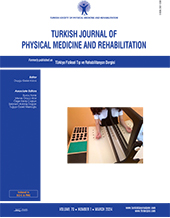Rehabilitation combined with dietary intervention improve urinary incontinence in women with obesity: A proof-of-principle study
2 Department of Surgical Sciences, Physical Medicine and Rehabilitation, University of Torino, Torino, Italy
3 Physical and Rehabilitative Medicine, Department of Health Sciences, University of Eastern Piedmont, Novara, Italy
4 Translational Medicine, Dipartimento Attività Integrate Ricerca e Innovazione (DAIRI), Azienda Ospedaliera SS. Antonio e Biagio e Cesare Arrigo, Alessandria, Italy
5 Department of Medical and Surgical Sciences, University of Catanzaro “Magna Graecia”, Catanzaro, Italy DOI : 10.5606/tftrd.2024.12573 Objectives: This study aimed to assess the impact of add-on pelvic floor exercises on a weight management rehabilitation program.
Patients and methods: This proof of principle study was conducted between July 2019 and December 2019. Ninety-three adult female inpatients with obesity and diagnosis of urinary incontinence (UI) were assessed for inclusion, and the suitable patients were randomly assigned to the experimental group and the control group. Both groups underwent a weight management rehabilitation program, while the experimental group also performed pelvic floor exercises. The primary outcome was UI severity, assessed by the 1-h pad test. Secondary outcomes were urinary symptoms, assessed by the International Consultation on Incontinence Questionnaire Short Form (ICIQ-SF), Patient Global Impression of Improvement (PGI-I), and Incontinence Quality of Life Questionnaire (I-QOL).
Results: Sixty female inpatients were randomly assigned to the experimental group [n=30; median age: 64.50 (51.25 to 70.50) years] or the control group [n=30; median age: 67.50 (58.50 to 74.75) years]. The experimental group showed a statistically significant reduction in UI severity [pad test: 2.08 (1.21 to 8.85) g vs. 0.54 (0.24 to 1.13) g, p<0.01; ICIQ-SF: 14.00 (10.25 to 17.00) vs. 8.00 (6.25 to 11.75), p<0.01; I-QOL: 56.37 (42.28 to 73.64) vs. 78.64 (64.32 to 90.68), p<0.01]. Statistically significant differences were found in the between-groups analysis [pad test: 0.54 (0.24 to 1.13) g vs. 1.08 (0.83 to 3.86) g, p<0.01; ICIQ-SF: 8.00 (6.25 to 11.75) vs. 12.00 (10.00 to 16.00), p<0.01; I-QOL: 78.64 (64.32 to 90.68) vs. 68.18 (60.00 to 84.32), p<0.01).
Conclusion: Including pelvic floor exercises might provide additional benefits compared to standard rehabilitation in reducing UI symptoms in obese women.
Keywords : Obesity; pelvic floor exercises; rehabilitation, urinary incontinence, weight management

















